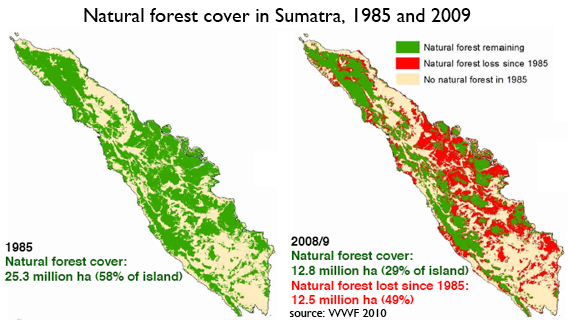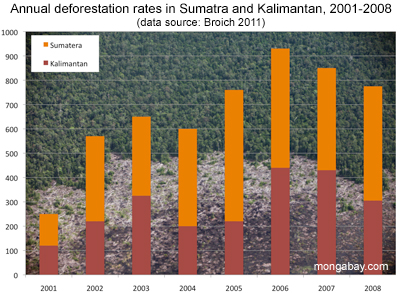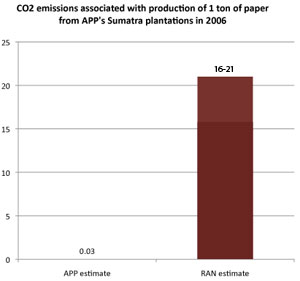
The Indonesian group Asia Pulp & Paper (APP) has been the target of many NGOs for years due to its alleged negative impacts on tropical forests. This culminated in a spectacular campaign launched by Greenpeace in 2011 based on Ken “dumping” Barbie. The rationale was that toy brand Mattel was accused of using APP paper products linked to the clear-cutting of natural forests in the Indonesian archipelago. APP organized a counter-attack in the media with the daily publication of advertisements promoting its sustainable development practices. Journalists from all over the world were also invited to attend guided tours of APP concessions to demonstrate their conservation efforts, and a number of articles were subsequently written.
What is really going on is the subject of discussion, in the midst of radical, yet legitimate, points of view from an environmental NGO and equally legitimate arguments from a major company to secure access to fiber as its main primary product.
First, the debate generally revolves around the issue of illegality for timber supplies, which, in this particular case, seems to be the wrong entry point for making the analysis. The main pulp and paper groups operating in Indonesia (APRIL is in a similar situation) have little reason to go beyond what they have already obtained by legal means: the Indonesian authorities have always been extremely lax in their treatment of these groups (possibly due to bribery), right from the very beginning of their public support in the 1980s. But objective arguments can be made against many of these decisions by national or sub-national authorities: indeed, while legality necessarily stems from a given convention, in this case the convention underlying all decisions regarding the pulp and paper sector in Indonesia is radically different from those found in other countries. To illustrate this point, it is accepted that primary forests are converted when degraded areas are also available, or that pulp mills obtain permits to expand when current processing capacities far exceed the secured sustainable supply of timber.
 Deforestation in Kalimantan and Sumatra |
In addition, while the notion of legality in Indonesia is questionable because of its substantial bias in favor of the pulp and paper industry, illegality also exists to varying degrees. Several examples come to mind: forest concession licenses are obtained through bribery from time to time; a number of supposedly compulsory conditions are not always met: peat depth (less than 3m), the condition of the forests subject to logging (less than 20 m2/ha of commercial species); and the balance between timber processing capacities and the development of timber plantation, among many others. Therefore, can we seriously consider that these groups operate legally even when forest concessions and the associated documents exist? It is clear at least that in this specific case, legality does not mean sustainability.
Second, another fundamental aspect of this debate regards the credibility of the promises made by APP, which tirelessly denies its own action plans and other commitments. In 2002, immediately after the financial crisis that hit the group and revealed its practices, APP promised to achieve a sustainable supply based on its acacia and eucalyptus plantations…by 2007. This was subsequently postponed for several years, and APP is now talking about 2015. One would have to be very naïve to believe this.
This leads us to the third point: what does a sustainable fiber supply for pulp production mean, and how can it be achieved? It is striking that this group proudly claims to use plantation fiber for around 60 percent of its needs. Is this really something to be proud of? Let us remind the reader that Indah Kiat, the group’s first pulp mill, began operating in 1984, nearly 30 years ago! Here, it is important to understand what this actually means: norms all over the world for pulp mills state that they must produce using plantation fiber only, and from the very beginning of their operations. Indonesia is a unique case in the world in terms of pulp production as it relies on Mixed Tropical Hardwood (MTH), which is a mix of species extracted from natural forests. This partly explains the impressive expansion of the sector in Indonesia, which climbed from 27th to 8th place among the world’s pulp producers in a decade (1988-1997). This was made possible by the political will (with all the associated subsidies) and by production costs among the lowest in the world because of almost free access to the country’s natural capital.
In this context, it would have been very reasonable to expect rapid and substantial investment in plantation development by these powerful and well-connected groups with a view to the transition towards sustainable supplies. This could have taken just a few years had there been a real strategy to achieve the goal. Yet this did not occur for at least two reasons. First, these groups have purposefully created the conditions for economic irreversibility: financial investments are huge, as are the pulp mills themselves; employment is significant (but extremely low per unit of invested capital, which is a crucial point); and debts must be repaid. Production must therefore be maintained at any cost. This situation was created in a very conscious and strategic manner because it allows these groups to secure constantly renewed access to natural forests according to the “too big to fail” hypothesis. In other words, for years APP has been in an ideal position to negotiate with the Indonesian authorities and with creditors; a position that could even be qualified as blackmail in certain circumstances: “if you do not allow us to continue producing at lowest cost through the destruction of natural forests, then we will close the pulp and paper mills, lay off employees and default on our debts.”
 Greenpeace’s stunt at Mattel’s headquarters on June 8, 2011. |
A second reason concerns the magnitude of fiber requirements. In order to operate at full capacity, the huge pulp mills of a group like APP would require more than a million hectares of fast-growing plantations (6-7 year rotations, equivalent to 100×100 km2). But this is unrealistic given that an increasing proportion of the land allocated to plantation development is peatland, where trees struggle to grow (not to mention the environmental problems associated with the drainage of these wetlands); social conflicts regularly arise when local populations claim their rights, and the logistic requirements represent a colossal challenge that has not yet been met (nothing close has ever been achieved in Indonesia so far).
In 2006, the group missed an opportunity to show its commitment to a sustainable path. A number of so-called “orphan plantations”—i.e. not linked to pulp mills—were established in Kalimantan (the Indonesian provinces of Borneo) and were at the disposal of the main pulp and paper groups as substitutes for the destruction of hundreds of thousands of hectares of natural forest in Sumatra. This opportunity was not taken, as these groups eventually decided to control the plantations in order to supply their pulp mills…in China.
It is important to note that these groups in fact have tremendous freedom of action, which impacts their present and future habits. In 2001, APP declared a moratorium on $13 billion of debt, making it the greatest default at that time in an emerging country, and one that appeared to be probably falsified. Taking advantage of the Asian economic crisis of the late 1990s, the group declared enormous losses, alleging that its debts were in U.S, dollars; yet the mills were able to benefit from falling domestic production costs following the spectacular devaluation of the Indonesian currency. It is widely known that these groups use double accounting systems. The lack of transparency in these accounts was never addressed, even when the context was conducive with the default and subsequent pressure from creditors.
 A 2010 report from the Rainforest Action Network (RAN) and the Japan Tropical Forest Action Network (JATAN) estimated carbon dioxide emissions from APP’s paper production at several levels of magnitude beyond what APP claimed. Overall the report estimated APP’s total net emissions (emissions offset by carbon sequestration by its plantations) at 67-86 million tons of CO2e in 2006, or more than that of 165 countries. At this time, APP said the report “grossly exaggerates and misstates APP’s carbon footprint”. |
One theory that was presented in more detail in recent research suggests in a counter-intuitive way that pulp and paper mills are merely “vehicles” for generating profit elsewhere, as the owners (the Widjaya family, one of the richest in the country) possess supply companies for fiber, insurance, chemicals, energy, etc. Thus, through the technique of “transfer pricing,” which is illegal, the owners find ways to create as much profit as possible in these satellite companies—timber, insurance, chemicals, etc.—with the sale of these products at prices well above market prices. They can do so because they control all of these entities, including the pulp and paper mills, even if their direct investments are relatively limited in the latter. On the other hand, they do not have any specific interest in making profit at the level of the mills because these are mainly financed through bank loans and international capital markets. The creditors were therefore unable to get reimbursed, as many factors impede their action: the opacity of the accounts, governance structures, rampant corruption in the national courts, and the fact that all valuable assets are concentrated in Indonesia (we will not address the Chinese issues here). Nonetheless, the context of the “Asian miracle” over previous decades and especially in the 1990s (wrongly) led these investors to believe that their investments would be highly profitable.
In the end, the availability of these natural forests has not only enabled the expansion of the Indonesian pulp and paper industry with renewed access to cheap fiber, but has also justified such a path. Indeed, the availability of forest resources has provided this industry with a goal: rent capture on a very large scale owing to extremely low production costs and the widespread practice of “transfer pricing” among the group’s entities. Furthermore, the underdevelopment of the plantations has been not only neglected, but also manipulated to provide a repeated negotiation argument: action plans for achieving the sustainable supply goal based on plantations are regularly announced—suggesting that the problem is on its way to being resolved or regulated – but are never fulfilled.
These elements must be borne in mind to anticipate the future steps and the credibility of APP’s media campaigns along with those of Greenpeace. They also put into perspective the group’s “efforts” towards forest and biodiversity conservation, whose media coverage seems closer to greenwashing than to a real willingness to ensure sustainable practices. Broadcasting the fact that careful attention has been given to Sumatran tigers by setting aside tens of thousands of hectares of forest, when almost a million hectares of natural (often primary) forests have been cleared over the last 30 years is more ironic than credible. The detailed analysis of the group’s structure, its financial and industrial practices, its links with the Indonesian authorities, its fiber supply practices and its huge negotiating power, all converge towards one single conclusion: APP has never changed its path, and apparently never will. This path is a serious threat to the remaining natural forests of Indonesia in general, and of Sumatra in particular.
For more information:
Pirard, R. and L.C. Irland, 2007, Missing links between timber scarcity and industrial expansion: the lessons from the Indonesian Pulp and Paper sector, Forest Policy and Economics, 9 (8), pp. 1056-70
Pirard, R. and R. Rokhim, 2006, Asia Pulp & Paper Indonesia: the business rationale that led to forest degradation and financial collapse, CIFOR Working Paper No. 33, Center for International Forestry Research (CIFOR), Bogor, 29 p.
Related articles
Controversial pulp and paper companies underwrite Indonesia’s climate change pavilion in Durban
(12/10/2011) A ‘significant proprtion’ of Indonesia’s $3.3. million pavilion at climate talks in Durban was funded by Indonesian pulp and paper companies companies, reports Reuters Alertnet.
First ever survey shows Sumatran tiger hanging on as forests continue to vanish

(11/10/2011) The first-ever Sumatran-wide survey of the island’s top predator, the Sumatran tiger (Panthera tigris sumatrae), proves that the great cat is holding on even as forests continue to vanish. The study, carried out by eight NGOs and the Indonesian government, shows that the tiger is still present in 70 percent of the forests surveyed, providing hope for the long-term survival of the subspecies if remaining forests are protected.
Toy giant Mattel drops paper from APP and other ‘controversial sources’

(10/05/2011) The world’s biggest toy-maker Mattel has pledged to overhaul its paper sourcing policies after a hard-hitting campaign from Greenpeace linked the toy giant to rainforest destruction in Indonesia by Asia Pulp and Paper (APP). Today, Mattel pledged to increase the use of recycled paper and sustainably-certified fiber to 70 percent by the year’s end, and 85 percent by 2015. In addition, the company has said any ‘controversial’ company engaged in natural forest destruction will be kept out of its supply line, referring to, but not naming directly, APP. Surprisingly, APP told mongabay.com that it ‘applauds’ Mattel’s new commitments.